Squat Stance: Understanding The Foundations
Author:
Reviewed by:
(21 years of Oly Lifting experience)
Unlock your full potential by engaging with our experts and community! Have questions about your fitness journey or looking for expert advice on weightlifting techniques? Don’t hesitate — leave a comment below and Daniel Arenas will provide a personalized answer and insights to help you reach your goals.
Torokhtiy is reader-supported. Some links are affiliate links, and we may earn a commission at no extra cost to you. See our disclosure page for details.
Starting your journey in the world of weightlifting goes much further away from raw strength, weightlifting requires precision, focus on technique and all around search for mastery of the foundations of the movements.
Squatting is the basis of all movements in weightlifting, in this article we’ll go through the foundations of squat stances, and different options on how to discover your proper squat stance, understanding that every athlete is unique and that the correct squat stance will vary to each lifter.
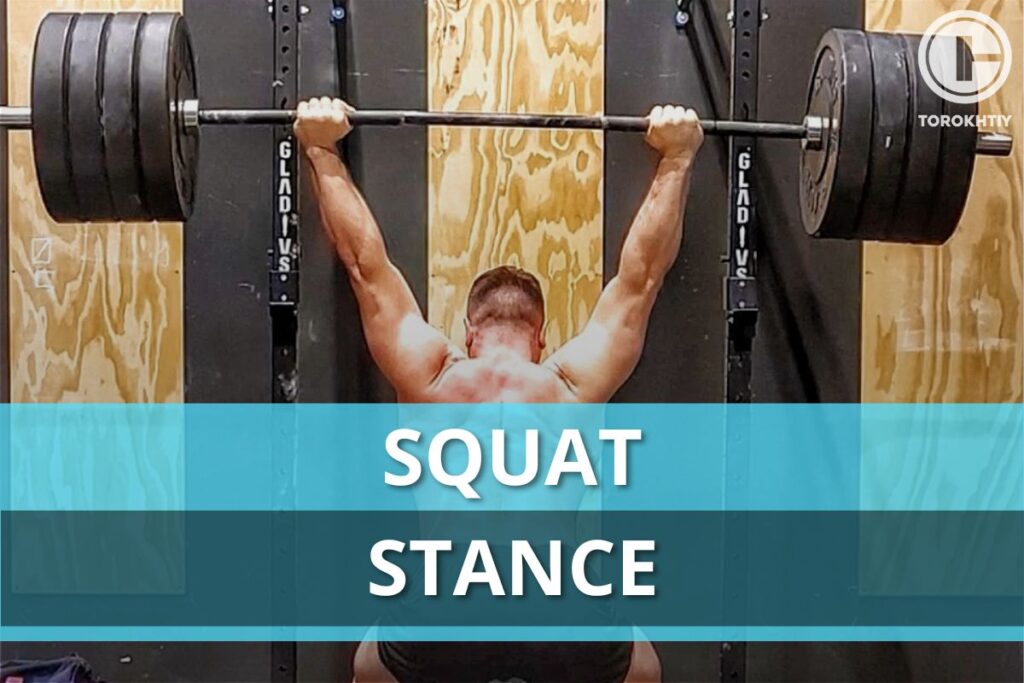
Why is correct squat stance important
1. Joint Health, Alignment and Stability:
The correct squat stance is going to help all joints included in the movement, including knee, ankle and hip stay align all throughout the range of motion, this will reduce the risk of injury and it’s going to allow you to stay healthy in the long term.
2. Muscle Engagement
A proper squat stance will help you activate the muscle groups that we want to engage in different scenarios, that’s why through this article we’ll talk about the different stances and why they’re used.
3. Spinal Alignment and Posture
Different bodies are built differently, but we all agree when we talk about squats we want to have a neutral and healthy spine, as our legs, hips, knees and ankles are built differently, the different squat stances all athletes use all focus on having their spine in a neutral and favored position.
4. Power Generation
How wide your squat stance should be also has an effect on the power you generate during the lift. It is demonstrated that changing your squat stance will significantly affect the forces applied and the muscle groups involved. Finding your right squat stance will help you optimize your power output and benefit your ability to squat heavier weights.
5 Factors affecting your squat stance
1. Squat Type
From everyone’s favorite Back Squat to its brother the Front Squat, also counting the classic Air Squat, and going through other variations like a narrow squat, a sumo squat, a Zercher squat and overhead squat, each variation may require a slight variation on you foot placement and practicing them will help you understand your body better.
2. Anthropometry
Your body’s proportions are one of the biggest factors into how wide your squat stance is. Every individual’s limb, torso, and femur length will play a significant role. For example, two individuals, who weigh the same, have the same height but differ in femur length, will have the need to have a different squat stance.
3. Mobility
Hip and ankle mobility will highly influence not only the range of motion, but also where the feet placement should be, as well as how far the knees will travel. Taking as an example, an individual who lacks ankle mobility in most times will need a wider stance or use elevated heels. If you think you lack mobility or just want to feel better when squatting, check our Squat Mobility Program here.
🔻GET A FREE PROGRAM DEMO: 12 Week Squat Program by Oleksiy Torokhtiy
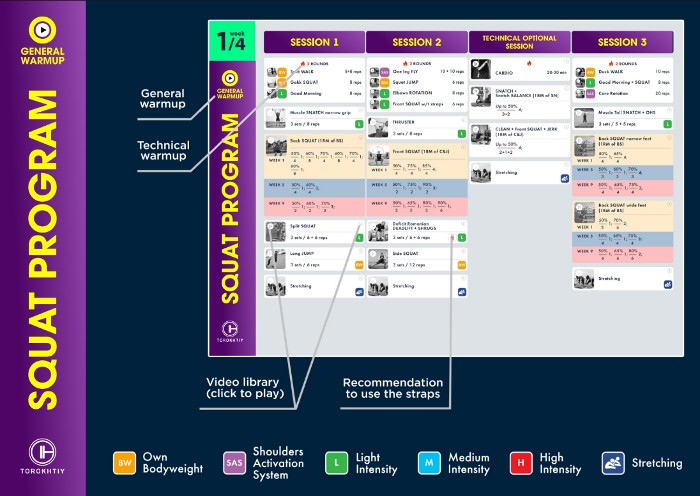
Do you want to double your squat strength? In just 12 weeks, you’ll be able to boost your squat results.
Enter your details and get a free demo (1 free week) of the squat program straight into your inbox.
4. Elevated Heels
For those athletes who lack sufficient ankle mobility will benefit from elevating their heels, by using weightlifting shoes or use¡ing a wedge under their heels, this may also influence their toe-out angle and width of their stance. If you want to check your ankle mobility, go and check our post with a home test you can do any time here.
5. Toe-out Angle
The angle you position your feet, known as the toe-out angle, can affect your comfort and the mechanics of your squat. Regularly, athletes find more comfort with an approximate 20° in combination with a moderate width stance (with feet approximately shoulder width apart). Study here.
Regular Squat Stance: a Detailed Step-by-Step Guide
There are many ways on how to describe a regular or proper squat stance, minding we’re all built differently and the stance will change for every athlete in the most minuscule detail, we can describe a regular squat stance following this guide.
1. Shoulder Width
Starting, heels should be placed approximately shoulder width apart, this is one of the most common ways to start providing balance in the feet.
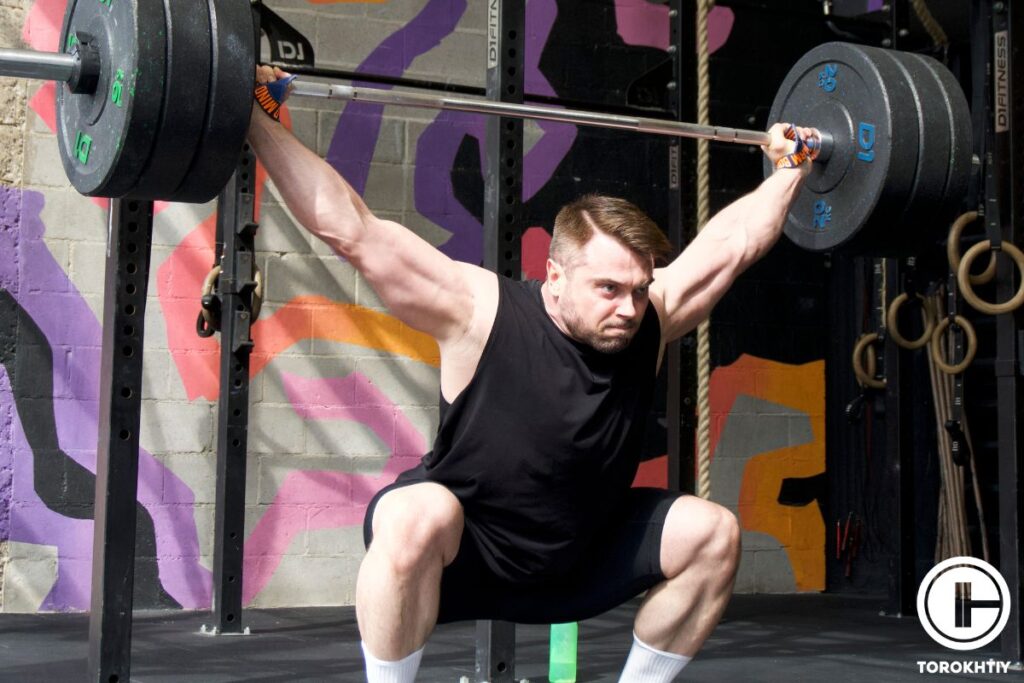
2. Toes and Knees Alignment
Make sure toes are pointing slightly outward, the most common angle would be around 20°, although some factors, like ankle and hip mobility could make this angle vary. And knees should track your toes the whole squat.
3. Torso Stance
Through your weightlifting journey, spinal health will be one of the highest factors you’ll want to take care off, when starting to squat, make sure you have a neutral spine, meaning the spine has its natural curvature, you can easily find this have your chest slightly out and core braced, as if you’re bracing for a punch in your stomach. Some coaches call this an ¨Athletic Stance¨, which is when the athlete has their chest and hip slightly out.
Follow us!

Free!
Get a 2-week Weightlifting Program as a bonus for the subscription to kickstart your training plan!

Free!
7 Other Types of Squat Stances
Some squat stances vary on the goal and what muscle group you want to work on, and it has been found that varying your stance will slightly promote hypertrophy responses on the muscle groups worked. Start with squat stance width and through the objective you have with it, let’s see some examples and how it changes.
1. Narrow-Stance Squat
Narrow Squats have various benefits, mostly for engaging the quadriceps during the eccentric (downwards) and concentric (upwards) movement. The stance for a narrow squat is having your feet approximately shoulder width apart, toes pointing slightly outward, aligning with the knees.
2. Wide-Stance Squat
Wide stance squats hit every muscle in the leg, but also add extra emphasis to the hip musculature such as glutes and hamstrings. In this stance the feet are positioned wider than shoulder width, toes point outward with knees tracking the toes, and it’s usually used to emphasize hip engagement and is commonly used by powerlifters.
3. Sumo-Stance Squat
The sumo squat places greater emphasis on the adductors (inner thighs), in this stance, the feet are positioned much wider than shoulder width and toes are pointing significantly outwards. This one is commonly used in powerlifting competitions.
4. Pistol-Squat Stance
Single leg squat or Pistol Squat requires significant strength, balance, coordination and flexibility, it engages the whole leg and regularly uses the glutes as the major muscle group used. This stance starts with only one leg on the floor and the other leg extended forward not touching the floor. This ability is used sometimes as a knee stability exercise.
5. Bulgarian-Split Squat Stance
This squat targets one leg at a time, emphasizing in the quadriceps, the hamstrings and glutes, it’s an excellent unilateral strength developer. To execute a Bulgarian Split Squat you need to place one foot forward and the other on an elevated surface, toes should point forward while the back foot provides support.
6. Hack Squat Stance
The hack squat is similar to a standard squat, but the body is positioned at a slight angle and the heels are slightly elevated. Toes may be pointed slightly outward. It is normally performed at a hack squat machine and emphasizes the use of the quadriceps.
7. Overhead Squat Stance
The overhead squat requires a lot of coordination and shoulder mobility, it is sometimes used as an accessory exercise to strengthen athletes in the overhead position when they’re at the bottom of a snatch. This stance is usually performed with feet wider than the regular squat or front squat stance, with a barbell or weight in the overhead position with arms fully extended.
How to find your ideal squat stance?
If you’re thinking how wide your squat stance should be, we have a couple of tips on how you can start figuring it out. These will help you get a start up on feeling what’s better for you and your anatomy.
Tip #1
There are many ways to find your best squat stance, as we have previously discussed, there’s no one size fits all, one of the easiest ways to find your best stance is using something for balance, let’s say placing your hands on a squat rack and squatting down with your feet together to your deepest squat, from here widen your feet until you can find a stance that allows you to have a straight back and active core.
Tip #2
Another way you can find your most comfortable squat stance is to start with an empty barbell or a pvc pipe placed on your traps, placing your heels shoulder width apart and slowly squatting down starting with your hip back, as you slowly squat down adjust your feet until you feel the most comfortable at the bottom of the squat while having your core tight, chest up and keeping a neutral spine.
Tip #3
In the end, finding your perfect squat stance is going to require a lot of trial and error, experiment with standard or sumo squat stance, analyze your body proportions, regularly people with a long femur prefer a wider stance while people with shorter femur usually prefer a narrower stance. Also, always consult a trainer or a coach, if you’re unsure of your ideal squat stance, consulting a coach can provide personalized tips that will guide you into your specific needs.
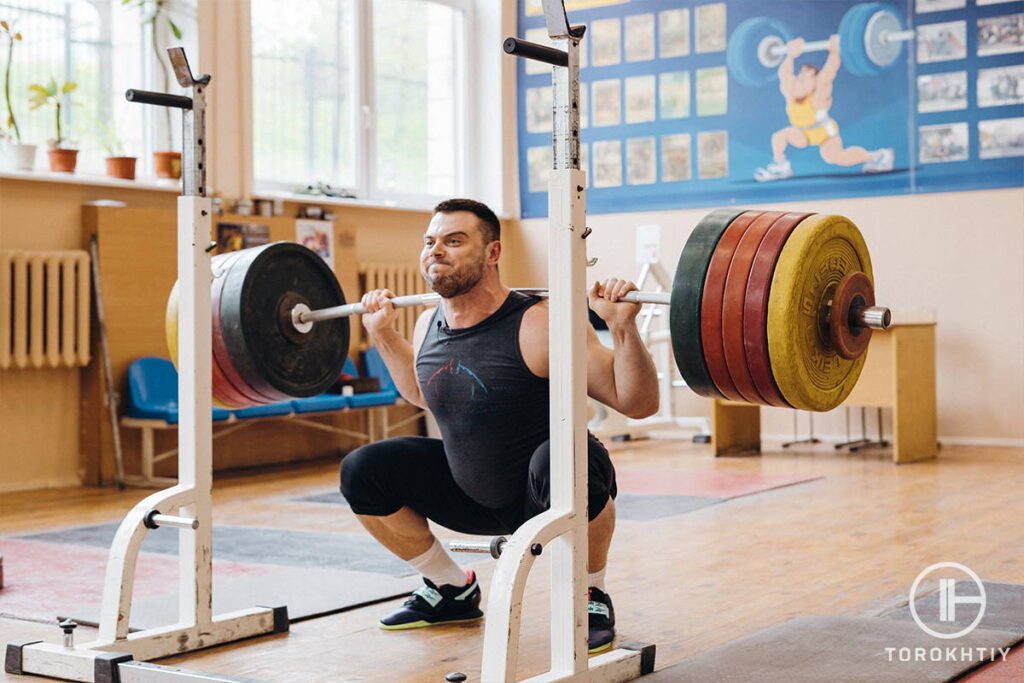
Conclusions
Remember that all individuals are different and we’ll always have different needs depending on our bodies and fitness goals, changing our foot placement will change the range of motion and lumbar curvature and because of this, it has to be chosen wisely.
Many different stances have many different goals and benefits, experiment on all of them and try to get better at them, most of all the ones you find the most difficult, because you’ll find the most benefit in getting better in the exercises you’re not-so-good at.
Do you have any other questions on how to find how wide your squat stance should be? And what other tips can you add to our list, comment below and share your best way to find a proper squat stance.
Also Read:
- What Muscles Do Squats Work? (Lifting Coach Explains)
- Squatting With Long Femurs: Tips For Lifters With Long Legs
- Squat and Deadlift Same Day: Right or Wrong?
- Safety Bar Squats: Form & Benefits Explained
- Lower Back Pain When Squatting: Causes & Fixes
- How To Get Bigger Wrists: Growth Strategies & Exercises
- How To Choose The Best Squat Wedge
- How Much Should I Be Able To Squat? Squat Standards Explained
- Do Squats Make Your Butt Bigger? (Improve The Result)
- Squat Sets And Reps: Everything You Need To Know
Referenses:
- Brad J Schoenfeld, ¨Squatting Kinematics and Kinetics and Their Application to Exercise Performance¨, The Journal of Strength and Conditioning, December 2010.
- Silvio Lorenzetti, Mira Ostermann, Fabian Zeidler, Pia Zimmer, Lina Jentsch, Renate List, William R. Taylor and Florian Schellenberg ¨How to squat? Effects of various stance widths, foot placement angles and level of experience on knee, hip and trunk motion and loading¨ National Library of Medicine, October 2018
- Ribeiro, Alex S. PhD; Santos, Erick D. MSc; Nunes, João Pedro MSc; Nascimento, Matheus A. PhD; Graça, Ágatha MSc; Bezerra, Ewertton S. PhD; Mayhew, Jerry L. PhD, ¨A Brief Review on the Effects of the Squat Exercise on Lower-Limb Muscle Hypertrophy¨, Strength and Conditioning Journal, February 2023.
- Dr. Aaron Horschig, PT, DPT, CSCS, USAW, Dr. Kevin Sonthana, PT, DPT, CSCS. How to Improve Knee Stability¨ Squat university, January 2016
- Silvio Lorenzetti, Mira Ostermann, Fabian Zeidler, Pia Zimmer, Lina Jentsch, Renate List, William R. Taylor & Florian Schellenberg, ¨How to squat? Effects of various stance widths, foot placement angles and level of experience on knee, hip and trunk motion and loading¨ BMC Sports Science, Medicine and Rehabilitation volume 10, Article number: 14 (2018)
Why Trust Us?
With over 20 years in Olympic weightlifting, strength training, nutrition coaching, and general fitness our team does its best to provide the audience with ultimate support and meet the needs and requirements of advanced athletes and professional lifters, as well as people who strive to open new opportunities and develop their physical capabilities with us.
By trusting the recommendations of our certified experts in coaching, nutrition, and sports training programming, as well as scientific consultants, and physiotherapists, we provide you with thorough, well-considered, and scientifically proven content. All the information given in the articles concerning workout programming, separate exercises, and athletic performance, in general, is based on verified data.
The product testing process is described in more detail here.
Daniel Arenas is a passionate Weightlifting and Functional Fitness coach hailing from Venezuela. With over seven years of dedicated coaching experience, he’s made it his mission to inspire and guide individuals on their fitness journey.
Reviewed by: Oleksiy Torokhtiy
Olympic Weightlifting Champion, PhD in Sport Science
Best Results: Snatch – 200 kg,
C&J – 240 kg
Oleksiy Torokhtiy is a professional athlete boasting 20 years of experience in Olympic weightlifting. With multiple European and World titles under his belt, he has showcased his prowess in two Olympic Games (Beijing 2008 and London 2012). Upon concluding his illustrious career, Oleksiy dedicated himself to coaching. By 2022, he had conducted over 200 weightlifting seminars worldwide. He is the visionary behind an international sportswear and accessories brand known for its motto, “Warm Body Cold Mind.” Additionally, he is an esteemed author and the creator of a series of training programs and eBooks.

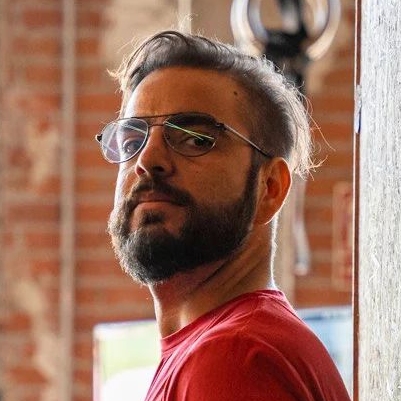


Still have questions after reading our article? Unlock your full potential by engaging with our experts and community! Don’t hesitate — leave a comment below and Daniel Arenas will provide a personalized answer and insights to help you reach your goals.